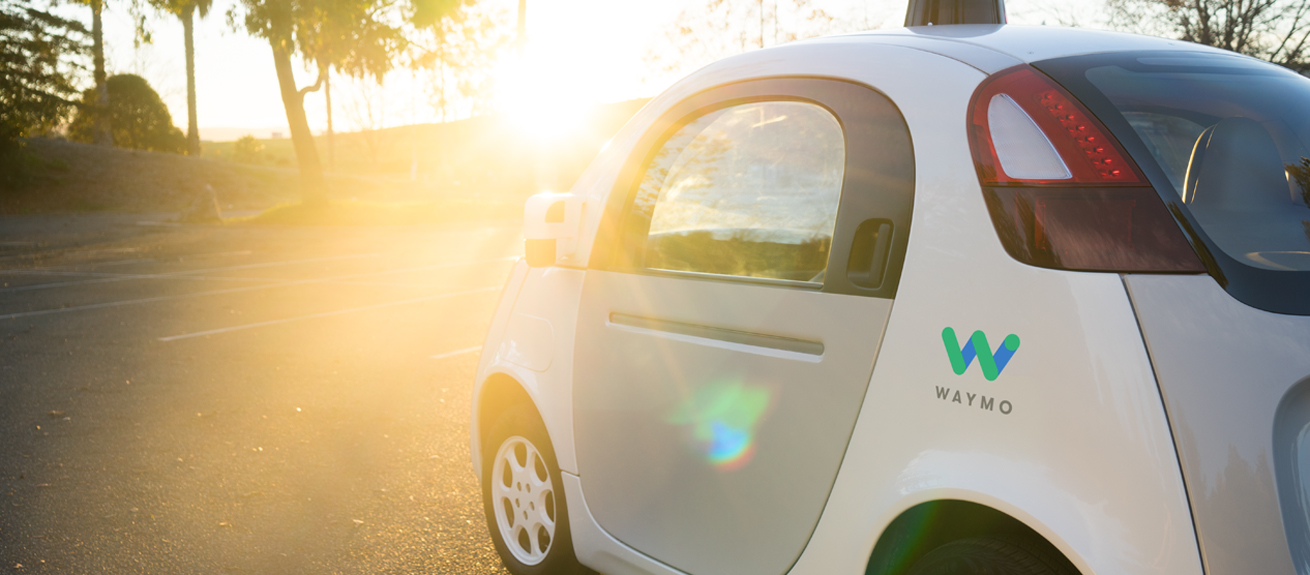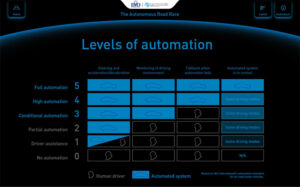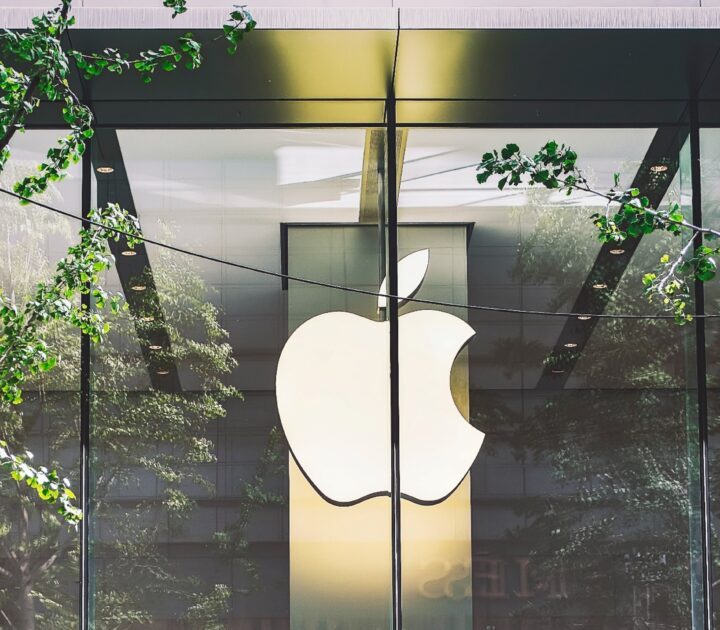This article is accompanied by the following interactive guide
In the late 1800s, a series of automobile engineering breakthroughs spurred a flurry of innovation, leading to hundreds of companies battling to deliver on the promise of fast, efficient, and reasonably-priced mechanical transportation. Since that time, innovation has been more steady than radical – the typical automobile of today works in much the same way as it did one hundred years ago.
Recently, we have seen a new race, prompted by breakthroughs in sensing technologies and artificial intelligence (AI). For the first time in history, the possibility of a car that doesn’t need a driver is within sight. Unlike the original wave of automobile innovation, the race for supremacy in autonomous vehicles is concentrated among a few corporate giants, not all of whom are automobile industry incumbents. This article and the accompanying interactive guide examine these players, show which are currently in the lead, and predict which are likely to win in the future.
Different Levels of Autonomy
Who will be the first to put fully autonomous vehicles on public roads? To answer this question, we first need to understand what full autonomy means. In 2014, the Society for Automotive Engineers (SAE) developed a 5-level taxonomy to describe different levels of automation (see Figure below). This taxonomy has since become the de facto standard approach to evaluate the progress towards full autonomy. A simplified explanation of the SAE autonomy levels are provided here:
Level 0: No Automation – The full-time performance of a human driver.
Level 1: Drive Assistance – In this level most functions are still controlled by the driver, but a specific function like steering or accelerating can be automated by the car. .
Level 2: Partial Automation – Here the car’s driver assistance system automates one or more aspects of the car using information about its driving environment. An example would be cruise control and lane-centering. If a driver can have his hands off the wheel and his foot off the pedal at the same time, we can consider it Level 2, like Tesla’s autopilot.
Level 3: Conditional Automation – Here all safety-critical functions of the vehicle are automated by the car. While the driver is still required to be in the car, he/she doesn’t have to monitor the situation as in the previous levels.
Level 4: High Automation – The car is fully autonomous, but is only designed to handle specific use cases, and cannot deal with every unpredictable driving scenario like unforeseen poor road conditions or sudden bad weather.
Level 5: Full Automation – Full-time performance by an automated driving system of all aspects driving in all conditions (roadway and environmental) that would normally involve a human driver.
Gear Heads vs Tech Nerds
While it’s impossible to know all the developments at any given time, particularly given a large proclivity for secrecy among the main players, we have tracked investments, strategic partnerships, and official press releases to learn more about what’s happening behind the scenes. We’ve analyzed six companies – three incumbents and three tech industry disruptors – that we believe are leading the autonomous driving race: GM, Ford, VW, Tesla, Uber, and Waymo (Google). The challenges of each group are different. A major challenge of the incumbents is to integrate self-driving technology into their existing fleet of mass produced vehicles, while the main challenge for the disruptors is to build a mass manufacturing capability. It is not clear which side will win. Here is a look at each player.
VW demonstrated its belief in alternative forms of transportation in 2016 when it invested $300M in Uber-rival Gett, a global on-demand transportation and delivery company. Since then, the company has added artificial intelligence expertise to its core and partnered with graphic chip company Nvidia to develop AI cockpit services for its car brands. In 2017, the VW Group unveiled the Audi A8 which is set to be the first Level 3 production vehicle on the market when released in 2018.
GM has acquired considerable technology expertise, including Sidecar Technologies, a B2B delivery transportation company, and Cruise Automation – a start-up that develops autopilot systems for cars. GM became the first company to build autonomous test vehicles in a mass production facility. Today, GM sells cars to the public with an SAE Level 2 autopilot functionality, and in November 2017, GM executives made a promise to operate a large-scale fleet of driverless cars in big cities by 2019. GM just announced the completion of Cruise AV, a car with level 5 autonomy, claiming to be the first production-ready car with no steering wheel or pedals. They are now seeking permission to begin testing.
Ever since Ford released its CEO and brought in James Hackett, the former smart mobility division head, in mid-2017, the company has made big strides in autonomous vehicle development. Ford, along with Chinese Internet giant Baidu, co-invested in Velodyne, a LIDAR company (a laser-based system for proximity sensing), and then went on to add machine learning, software, and digital transformation expertise through additional acquisitions. In February 2017, the company invested $1BN in Argo AI, an artificial intelligence company for self-driving vehicles. Ford also ran a trial with Domino’s Pizza to test pizza delivery using autonomous vehicles. The company currently sells cars with Level 2 autopilot systems, but is testing Level 4 cars on public roads.
Tesla was the first mover in this space, launching Level 2 autopilot functionality in 2015 in the Model S sedan. In 2016, Tesla announced that all new cars going forward would have the hardware for full autonomy. Some experts have challenged Tesla, arguing that the company has merely added surround cameras to its production cars, and not demonstrated any capability in an advanced computer vision system as precise as LIDAR. However, Tesla has been around for a long time, collecting data from hundreds of thousands of cars, driving millions of miles across all terrains. Thus, we should not dismiss Elon Musk, when he says he is confident that a Level 4 vehicle will drive from a parking lot in LA to New York without any human interference, something we have not seen happen yet.
Uber has been testing autonomous cars on the streets of Pittsburgh since 2016, always with an Uber employee behind the wheel ready to take over in case of a malfunction. Uber purchased Otto, a self-driving truck company, in 2016 for a reported $680M. Soon thereafter, they expanded their machine learning and AI capabilities, demonstrating to the world how serious they were about autonomous vehicles. Uber is currently testing Level 4 vehicles in several locations in the United States, always with a human in the car. Volvo has agreed to provide 24,000 cars to Uber in a non-exclusive deal from 2019 – 2021. Recently, Uber also announced a partnership with Toyota and Nvidia.
Waymo emerged from a 2009 ‘Google X’ project, and since 2016 has become a wholly-owned, independent entity. Today, the Waymo vehicles have clocked more than 300,000 autonomous miles. In 2015, Waymo’s Firefly was released, a SAE Level 5 vehicle without steering wheel or pedals, which was tested across a variety of driving situations. In 2017, the company retired Firefly, opting instead to build hardware that could be installed on production cars from any vendor. Also in 2017, Waymo added the Chrysler Pacifica minivan to its fleet as the first vehicle built on a mass-production platform with fully-integrated Waymo hardware, with the aim of full autonomy. Waymo is testing these vehicles, without driver or monitor in the car, in Arizona through its early rider program. The company’s experience, technology capability, and ability to secure solid partnerships currently puts them at the head of the pack.
View the interactive guide here
The Bottom Line
The race to fully autonomous driving is in full swing, with competitors ranging from industry incumbents to disruptive digital outsiders. The stakes are high. In 2017, one hundred million news cars and trucks were sold around the world, and the top ten automobile manufacturers accounted for 1.5 trillion dollars in revenue. Car and truck sales are likely to be hit hard by the popularization of autonomous vehicles. Other industries, like insurance, healthcare, logistics, real estate, and hospitality are also likely to be affected. In short, autonomous vehicles are likely to impact a number of industries, with winners and losers on all sides. At the moment, the disruptors like Tesla, Waymo, and Uber seem to have the upper hand, but it is too early to count out the incumbents, who have significant industry momentum on their side.







